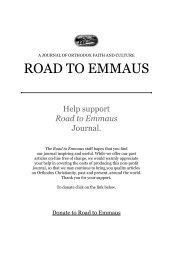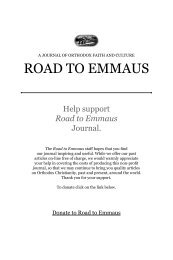RTE No 20 Interior - Road to Emmaus Journal
RTE No 20 Interior - Road to Emmaus Journal
RTE No 20 Interior - Road to Emmaus Journal
Create successful ePaper yourself
Turn your PDF publications into a flip-book with our unique Google optimized e-Paper software.
<strong>Road</strong> <strong>to</strong> <strong>Emmaus</strong> Vol. V, <strong>No</strong>. 4 (#19)he was in central Asia, but they don’t speak of any adventures in thoseplaces, so this means that either the texts were destroyed or nothing of notehappened. Usually we only write down the difficult or the very miraculous,so if his visits were peaceful, perhaps the accounts didn’t survive.<strong>RTE</strong>: Is Sogdiana anywhere near the Chinese region where they recentlyfound first-century Christian inscriptions and <strong>to</strong>mbs?GEORGE: <strong>No</strong>, those <strong>to</strong>mbs are at the other end of China, but there was possiblya Chinese disciple of St. Thaddeus of the Seventy, whose name is St.Aggai in the Syriac tradition. This Aggai is said <strong>to</strong> have preached in Parthia,in Sogdiana, and in central Asia: Uzbekistan, Afghanistan, Pakistan, Iranand India. He found the <strong>to</strong>mb of St. Thomas in southern India, and aftervenerating the fragrant relics of St. Thomas, he died. His name in theChinese sources may have been Wang-Hai – the important thing here isthat according <strong>to</strong> the sources he was a silk producer and we know that noone could be a silk producer at that time unless he was Chinese. So, perhapsSt. Aggai was the first Chinese disciple of an apostle of Christ. These newlydiscoveredChristian <strong>to</strong>mbs and monuments date from about 75 A.D., sothese really were apos<strong>to</strong>lic times.There are also traditions from the Yellow Sea, near Shanghai, of St.Thomas having been in China. This is not physically impossible because thearea where modern-day Kazakhstan borders Mongolia and China was thecradle of the Huns, the eastern Scythians, and the Sacas. Gundophorus, theking of India who met St. Thomas, was a Sacan king, and the Sacan empirewas vast, stretching from Siberia <strong>to</strong> China and India. People knew theseroutes, they were well-traveled.The Pro<strong>to</strong>-Bulgarians who followed the Huns even had a church dedicated<strong>to</strong> St. Andrew, although after later invasions they had <strong>to</strong> be re-Christianized. Also we have the Hephtalit Huns, a barbaric Turcik tribe whowere the first Christian nation in central Asia (third-fourth century).It is very important <strong>to</strong> understand that there are three separate traditionsof St. Andrew’s missionary journeys <strong>to</strong> western China, eastern-central Asia,and Kalbin (Khalbinski Hrebet, a mountainous area on the borders of present-dayKazakhstan, Mongolia, and Russia.) One of these traditions is fromKazakhstan, another is Syriac, and the third is from the Bulgars of theRussian steppes, who migrated through Greece and eventually settled inItaly, filling their villages with churches dedicated <strong>to</strong> St. Andrew.26Synaxis of All Saints of Karelia, St. Andrew in front.










